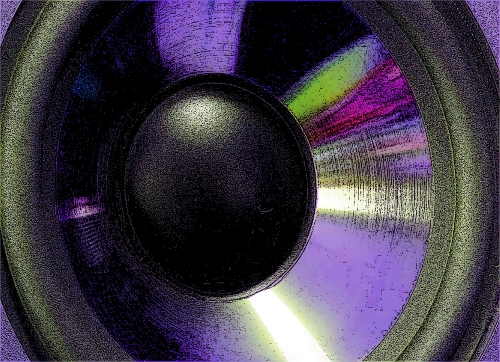
The Cabinet
The cabinet and its construction are a major factor regarding the price of a loudspeaker. Cabinets must be strong and stiff. If the cabinet vibrates it becomes a transducer itself, which will interact with the other transducers and degrade the overall system performance. A stiff cabinet requires a lot of mass, a lot of bracing, or both. The trade-off is the weight of the box.
Concrete is an excellent cabinet material, but is impractical for all but custom subwoofer systems. Medium density fiberboard (MDF) is also a good material. It is very dense and low cast, but it is also very heavy and is subject to warping if it gets wet.
Particle board cabinets are cheap, but should be avoided. Plywood is lighter and stronger than MDF, but it can have voids between the layers. Baltic birch plywood is best (11+ layers and free of voids), but it is also the most expensive wood for loudspeaker building.
Composite materials can be very strong and very light, but are also very expensive. Fiberglass is strong and weather-resistant, yet it is difficult to fabricate and therefore much more expensive than wood or plastic.
Molded-plastic loudspeaker cabinets have become common in recent years. They are lightweight and can be made weather-resistant. The initial high tooling costs incurred by the manufacturer are recovered through mass production over many years. This type of cabinet construction is practical for small-dimensioned enclosures, but more rigid materials are required for large boxes.
Loudspeakers that will be flown over an audience must have special rigging hardware (fly-points). They must also be pull-tested to ensure cabinet and hardware integrity.
Fly-able loudspeakers don’t look a lot different than ground-stack or pole-mount loudspeakers, but will generally cost a good deal more due to the required cabinet construction, integral fly-points, and testing.
Self-Powered Loudspeakers
I have shown that the loudspeaker is a system of inter-dependent parts. This can be expanded to include the power amplifier. Amplifier selection can be complicated, and the ramifications for choosing the wrong one can be disastrous.
This has prompted some manufacturers to incorporate the amplifier and signal processing right into the loudspeaker. These are commonly called self-powered loudspeakers. This was not a practical approach with older amplifier topologies, but modern Class-D amplifiers are relatively small and lightweight, and they are also very efficient. They can be incorporated into the loudspeaker cabinet without undue increases in size or weight.
The result is a plug-and-play loudspeaker that needs only an electrical outlet and a signal from a mixer. Of course, self-powered loudspeakers will be comparatively more expensive than passive models. They can also be more difficult to install since they require AC power.
Both passive and self-powered loudspeakers can provide equivalent levels of performance. The pros and cons of each must be considered in light of the application.
Loudspeaker Specifications
Loudspeakers should be tested by the manufacturer and supplied with performance data. Some key specifications include sensitivity, power handling, coverage angles, and impedance.
These specs are useful for providing a general idea of a loudspeaker’s performance (and hence its suitability for a project), yet they should not be used for comparison shopping between brands. This is especially true for power ratings, which are seldom understood and usually wildly exaggerated. One big difference between loudspeaker brands is the availability of engineering data for use in computer modeling programs. This data goes far beyond the spec sheet that almost all loudspeakers have.
A popular program among sound system designers is the Enhanced Acoustic Simulator for Engineers (EASE). Another is CATT-Acoustic. One data type is proprietary to the EASE program, and others (i.e., the Common Loudspeaker File Format or CLF) are generic.
A very quick way to narrow the field when selecting loudspeakers is to only consider models that are accompanied by EASE or CLF data. The testing required to produce this data is extensive, so its availability is usually limited to professional models.
Consistent Quality
Since the loudspeaker is a system of interdependent parts, the selected transducers must be of similar quality and have a similar level of performance. A better MF driver must be accompanied by better LF and HF drivers for the benefits to be realized.
The same is true for the enclosure and crossover network. It makes no sense to combine high-quality components with a cheap enclosure. This is like building a house, where it is sensible to be consistent with the quality of materials. You don’t mount solid gold faucets onto a cheap sink.
But as with a house, if each part selected is a little better, then the cost of the whole will be much greater.
Conclusion
Remember to compare apples with apples when evaluating loudspeakers. Consider a loudspeaker with the following attributes:
— Cast-frame LF transducer
— Fiberglass MF horn with compression driver
— ABS plastic HF horn with compression driver
— Baltic birch cabinet rated for overhead use
— Integral fly-points
— Robust internal crossover network (if applicable)
— EASE and CLF performance and design data
— Technical support department and available parts
The cost of a loudspeaker is affected by all of these factors and others. Even in a competitive marketplace, a loudspeaker with these attributes will not be cheap. If one brand is half the price of all the others, then “buyer beware.”
With loudspeakers, you get what you pay for and you can expect to pay for what you get. A loudspeaker represents a set of compromises and trade-offs.
A competent sound system designer can weigh these out to select an appropriate make and model for your specific application.
